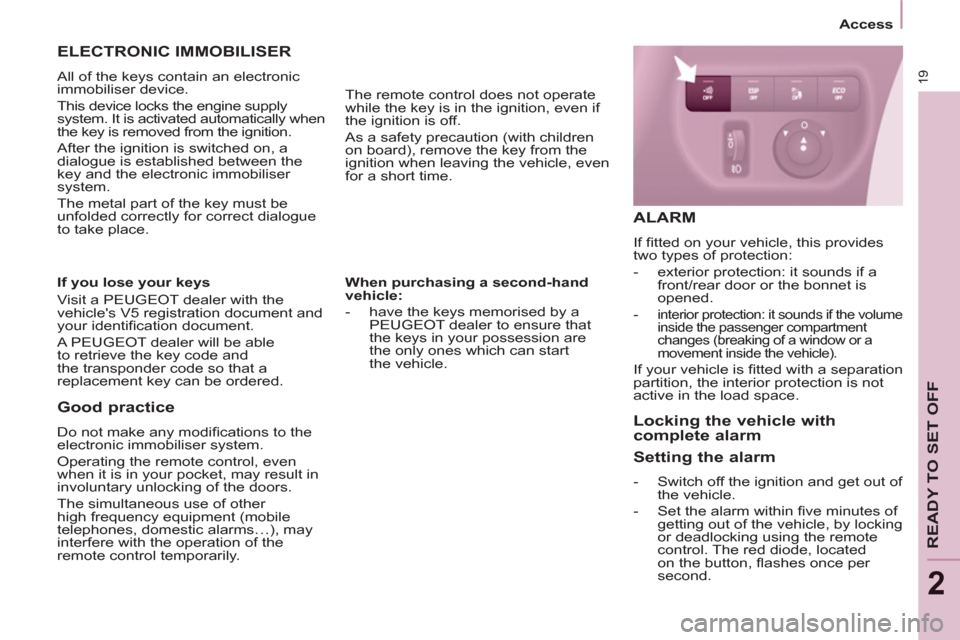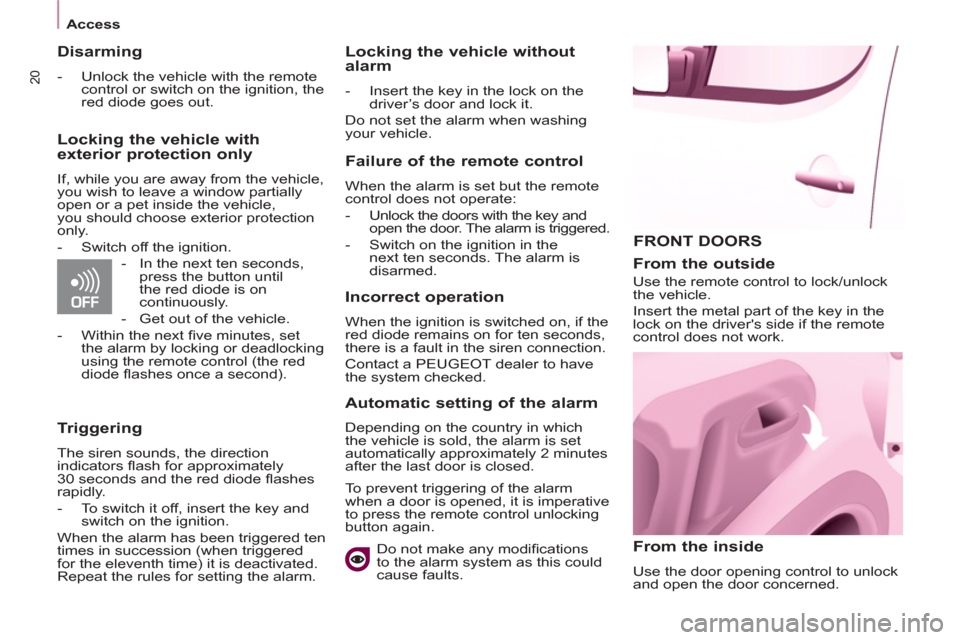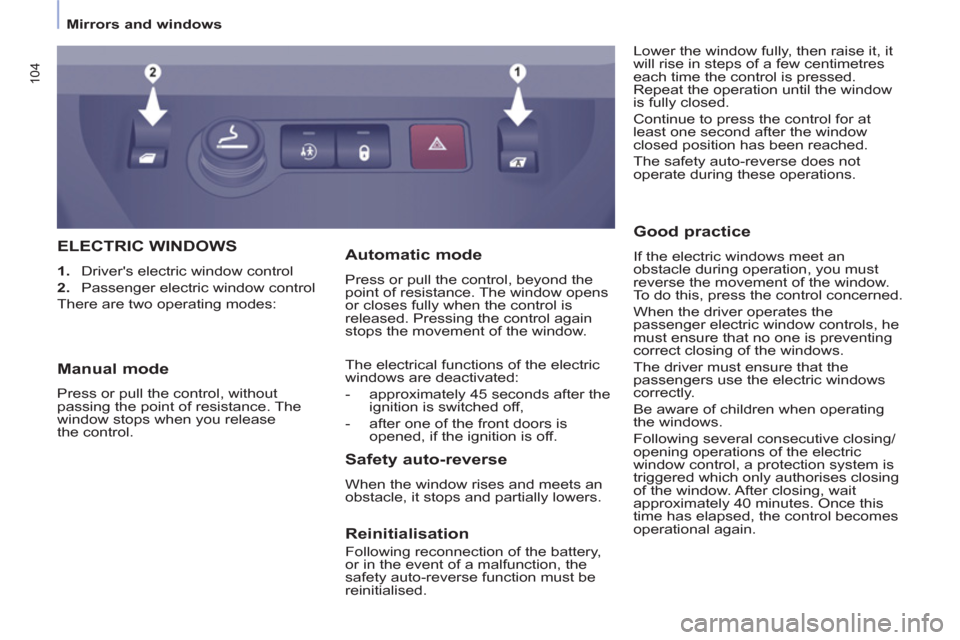2011 Peugeot Partner Tepee window
[x] Cancel search: windowPage 4 of 232

2
Contents
Key 17
Alarm 19
Doors 20
Tailgate 22
Rear roof fl ap 25
Central locking 26
Instrument panel 27
Adjusting the time 28
Warning lamps 29
Fuel gauge 35
Coolant 35
Tyre under-infl ation
detection 36
Service indicator 37
Lighting rheostat 38
Gearbox 39
Gear shift indicator 39
6-speed electronic
gearbox system 40
Steering wheel
adjustment 42
Stop & Start 43
Starting and stopping 46
Hill start assist 47Lighting control 48
wipers 51
Cruise control 53
Speed limiter 56
Heating/Manual air
conditioning 59
automatic 61
De-icing and demisting 63
Front seats 65
Rear bench seat 67
Rear seats
(5 seat version) 70
Rear seats
(7 seat version) 73
Adjustments 80
Front fi ttings 82
Zenith roof 86
Roof bars 91
Courtesy lights 92
Torch 93
Load space cover
(5 seat version) 94
Load space cover
(7 seat version) 98
Interior rack 100
Mirrors 102
Electric windows 104
2. READY TO SET OFF
17-47
4. SAFETY
105-126
Presentation 4
Communication 4
Exterior 6
Instruments and controls 8
Centre console 9
Sitting comfortably 10
Visibility 11
Driving safely 12
Passenger compartment
space 13
Rear fi ttings 14
Child safety 15
Ventilation 16
1. FAMILIARISATION
4-16
Hazard warning lamps 105
Parking brake 105
Rear parking
assistance 106
Anti-lock braking system
(ABS) 108
Emergency braking
assistance 108
Traction control (ASR) and
stability control (ESP) 109
Grip control 110
Seat belts 113
Airbags 116
Disarming the passenger
airbag 119
Child seats 120
Recommended seats 121
Installing 122
Isofi x seats 125
Child lock 126
3. EASE OF USE and
COMFORT 48-104
Page 11 of 232

4
2
4
9
1
FAMILIARISATION
Interior
CENTRE CONSOLE
1.
Control panel: electric windows.
2.
Control panel: hazard warning
lamps, central locking.
3.
Cigar lighter.
4.
Heating-ventilation controls.
5.
Storage compartment.
110
6.
Grip Control.
7.
Audio equipment.
8.
Screen.
40
9.1
10.
Emergency call.
9.
Electronic
gearbox selector
lever.
Page 21 of 232

19
Access
READY TO SET OFF
2
When purchasing a second-hand
vehicle:
- have the keys memorised by a
PEUGEOT dealer to ensure that
the keys in your possession are
the only ones which can start
the vehicle.
Good practice
Do not make any modifi cations to the
electronic immobiliser system.
Operating the remote control, even
when it is in your pocket, may result in
involuntary unlocking of the doors.
The simultaneous use of other
high frequency equipment (mobile
telephones, domestic alarms…), may
interfere with the operation of the
remote control temporarily.
ELECTRONIC IMMOBILISER
All of the keys contain an electronic
immobiliser device.
This device locks the engine supply
system. It is activated automatically when
the key is removed from the ignition.
After the ignition is switched on, a
dialogue is established between the
key and the electronic immobiliser
system.
The metal part of the key must be
unfolded correctly for correct dialogue
to take place.
If you lose your keys
Visit a PEUGEOT dealer with the
vehicle's V5 registration document and
your identifi cation document.
A PEUGEOT dealer will be able
to retrieve the key code and
the transponder code so that a
replacement key can be ordered.
The remote control does not operate
while the key is in the ignition, even if
the ignition is off.
As a safety precaution (with children
on board), remove the key from the
ignition when leaving the vehicle, even
for a short time.
ALARM
If fi tted on your vehicle, this provides
two types of protection:
- exterior protection: it sounds if a
front/rear door or the bonnet is
opened.
-
interior protection: it sounds if the volume
inside the passenger compartment
changes (breaking of a window or a
movement inside the vehicle).
If your vehicle is fi tted with a separation
partition, the interior protection is not
active in the load space.
Locking the vehicle with
complete alarm
Setting the alarm
- Switch off the ignition and get out of
the vehicle.
- Set the alarm within fi ve minutes of
getting out of the vehicle, by locking
or deadlocking using the remote
control. The red diode, located
on the button, fl ashes once per
second.
Page 22 of 232

20
Access
FRONT DOORS
From the inside
Use the door opening control to unlock
and open the door concerned.
From the outside
Use the remote control to lock/unlock
the vehicle.
Insert the metal part of the key in the
lock on the driver's side if the remote
control does not work.
Disarming
- Unlock the vehicle with the remote
control or switch on the ignition, the
red diode goes out.
Locking the vehicle with
exterior protection only
If, while you are away from the vehicle,
you wish to leave a window partially
open or a pet inside the vehicle,
you should choose exterior protection
only.
- Switch off the ignition.
- In the next ten seconds,
press the button until
the red diode is on
continuously.
- Get out of the vehicle.
- Within the next fi ve minutes, set
the alarm by locking or deadlocking
using the remote control (the red
diode fl ashes once a second).
Triggering
The siren sounds, the direction
indicators fl ash for approximately
30 seconds and the red diode fl ashes
rapidly.
- To switch it off, insert the key and
switch on the ignition.
When the alarm has been triggered ten
times in succession (when triggered
for the eleventh time) it is deactivated.
Repeat the rules for setting the alarm.
Locking the vehicle without
alarm
- Insert the key in the lock on the
driver’s door and lock it.
Do not set the alarm when washing
your vehicle.
Failure of the remote control
When the alarm is set but the remote
control does not operate:
- Unlock the doors with the key and
open the door. The alarm is triggered.
- Switch on the ignition in the
next ten seconds. The alarm is
disarmed.
Incorrect operation
When the ignition is switched on, if the
red diode remains on for ten seconds,
there is a fault in the siren connection.
Contact a PEUGEOT dealer to have
the system checked.
Automatic setting of the alarm
Depending on the country in which
the vehicle is sold, the alarm is set
automatically approximately 2 minutes
after the last door is closed.
To prevent triggering of the alarm
when a door is opened, it is imperative
to press the remote control unlocking
button again.
Do not make any modifi cations
to the alarm system as this could
cause faults.
Page 66 of 232

64
Ventilation
DE-ICING AND DEMISTING GOOD PRACTICE
Vents
"Leave them open"
For optimum distribution and diffusion
of hot or cool air in the passenger
compartment, there are adjustable
central and side vents which can
be directed sideways (right or left)
or vertically (up or down). For your
comfort while driving, do not close
them and direct the fl ow of air towards
the windows instead.
Air vents in the footwells and directed
towards the windscreen complete
the equipment.
Do not block the vents located at the
windscreen or the air extractor located
in the boot.
Dust filter, odour filter (activated
carbon)
This fi lter traps certain dust and limits
odours.
Ensure that this fi lter is in good
condition and have all of the fi lter
elements replaced regularly.
Refer to the "Checks" section of
chapter 6.
Air conditioning
In all seasons, the air conditioning
should only be used with the windows
closed. However, if the interior
temperature remains high after a
prolonged period parked in the sun, do
not hesitate to ventilate the passenger
compartment for a few minutes.
Use the AUTO mode as much as
possible as it permits optimised
control of all of the functions: air fl ow,
passenger compartment comfort
temperature, air distribution, air
intake mode or air recirculation in the
passenger compartment.
Operate the air conditioning system for
5 to 10 minutes, once or twice a month,
to keep it in perfect working order.
It is normal that the condensation
created by the air conditioning system
results in a fl ow of water which may
form a puddle under the vehicle when
parked.
If the system does not produce cold air,
do not use it and contact a PEUGEOT
dealer.
Automatic mode: visibility
programme
The comfort programme (AUTO) may
not be suffi cient to quickly demist or
de-ice the windows (humidity, several
passengers, ice).
In this case, select the visibility
programme. The visibility programme
indicator light comes on.
It activates the air conditioning, the air
fl ow and provides optimum distribution
of the ventilation to the windscreen and
side windows.
It deactivates the air recirculation.
Page 104 of 232

102
Mirrors and windows
Electric exterior mirrors
- Move the control to the right or to
the left to select the corresponding
mirror.
- Move the control in all four
directions to adjust.
- Return the control to the central
position.
Electric folding/unfolding
The mirrors can be folded or unfolded
electrically from the inside, with the
vehicle parked and the ignition on:
- Place the control in the central
position.
- Turn the control downwards.
MIRRORS
Heated mirrors
The electric mirrors can be heated.
Manual exterior mirrors
Move the lever in all four directions to
adjust.
When the vehicle is parked, the
exterior mirrors can be folded back
manually.
The mirrors are not equipped with
automatic de-icing.
Forced folding
If the mirror casing has come out of
its initial location, with the vehicle
stationary reposition the mirror casing
manually or use the electric folding
control. Press the rear screen
de-icing button.
Page 105 of 232

103
EASE OF USE AND COMFOR
T
3
Mirrors and windows
MONITORING MIRROR
This mirror, placed on top of the
central mirror, enables the driver or
front passenger to observe all the rear
seats.
Fitted on its own ball joint, it's manual
adjustment is simple and provides a
view of the rear interior of the vehicle.
It can also be adjusted for improved
visibility during manoeuvres or when
overtaking.
Areas for toll cards/car park
tickets
The athermic windscreen has two non-
refl ective zones located either side of
the base of the interior mirror.
They are intended for affi xing toll cards
and/or car park tickets.
REAR WINDOWS
To partially open the rear windows, tilt
the lever and push it fully to lock the
windows in the open position.
Manual interior mirror
The interior mirror has two positions:
- day (normal),
- night (anti-dazzle).
To change from one to the other, push
or pull the lever on the lower edge of
the mirror.
Page 106 of 232

104
Mirrors and windows
ELECTRIC WINDOWS
1. Driver's electric window control
2. Passenger electric window control
There are two operating modes: Lower the window fully, then raise it, it
will rise in steps of a few centimetres
each time the control is pressed.
Repeat the operation until the window
is fully closed.
Continue to press the control for at
least one second after the window
closed position has been reached.
The safety auto-reverse does not
operate during these operations.
Safety auto-reverse
When the window rises and meets an
obstacle, it stops and partially lowers.
Automatic mode
Press or pull the control, beyond the
point of resistance. The window opens
or closes fully when the control is
released. Pressing the control again
stops the movement of the window.
The electrical functions of the electric
windows are deactivated:
- approximately 45 seconds after the
ignition is switched off,
- after one of the front doors is
opened, if the ignition is off.
Good practice
If the electric windows meet an
obstacle during operation, you must
reverse the movement of the window.
To do this, press the control concerned.
When the driver operates the
passenger electric window controls, he
must ensure that no one is preventing
correct closing of the windows.
The driver must ensure that the
passengers use the electric windows
correctly.
Be aware of children when operating
the windows.
Following several consecutive closing/
opening operations of the electric
window control, a protection system is
triggered which only authorises closing
of the window. After closing, wait
approximately 40 minutes. Once this
time has elapsed, the control becomes
operational again.
Manual mode
Press or pull the control, without
passing the point of resistance. The
window stops when you release
the control.
Reinitialisation
Following reconnection of the battery,
or in the event of a malfunction, the
safety auto-reverse function must be
reinitialised.